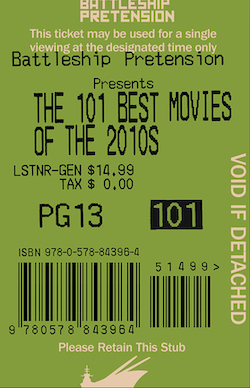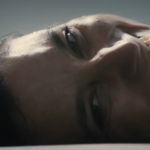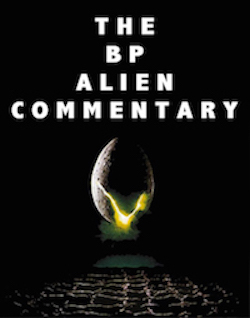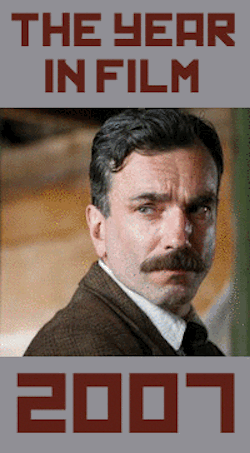Bigger Than Life, by Scott Nye
For those who know them, William Wellman’s The Great Man’s Lady and Roxie Hart may seem an odd pair, but paired they were last night as part of UCLA’s now-concluded retrospective of the American director’s work. The former is a majestic, sweeping epic of a weepie; the latter just about the most savage bit of revelry I’ve seen this side of the Code. Beyond offering a glimpse into Wellman’s diversity, and that they were both released in 1942, the films make a fine pair in another way – they’re both tall tales.
The Great Man’s Lady begins roughly in the present. A statue is about to be unveiled commemorating the life of one Ethan Hoyt, former senator and founder of their fictional Hoyt City, a burgeoning metropolis located in the vague Midwest. The city is stacked to the brim with skyscrapers, save for one house right in the middle – Ethan Hoyt’s former residence, now occupied by the one-hundred-year-old Hannah Sempler (Barbara Stanwyck). Why she lives there remains a mystery, and the subject of much gossip and speculation. The reporters have had enough, and they barge in; Hannah finally caves and tells her story to an unnamed biographer (Katherine Stevens, literally credited as “Girl Biographer”).
The story is as grand a tale as one could conjure, filled with dangerous journeys, uncertain futures, frontier towns, manifest destiny, gold, silver, love affairs, gambling, and, of course, regret. Did they do everything she says? One piece of physical evidence, unveiled during the film’s tear-soaked finale, suggests it must have. But its veracity is less important than its honesty. Its portrait perpetuates any number of American myths – that this country was built by the brave (who were called foolish), that whatever you can grab hold of is rightfully yours – while subverting one important one: it recognizes that many men are indeed fools, and could not achieve greatness without the right woman at their side. Hannah is more than the long-suffering wife, though. She, too, is greedy, callous, lustful, and naive, literally running off with Ethan in in the middle of the night and never looking back. The Great Man’s Lady romanticizes this Old West – still relatively recent history in the context of 1942, but just far enough gone that all that remains is the romance. Life was hard, then, such films assert, but the people were harder, and this country is better for their sacrifice.
Roxie Hart is similarly outlandish, though the history it fictionalizes is much more recent. A newspaperman rushes from the scene of a crime to a local bar, mourning to his fellow drunkards that murders just aren’t what they used to be. Do they remember, he wonders, the story of Roxie Hart? The Chicago showgirl who uses her murder conviction to make a name for herself? And if that story sounds familiar, yes, its basis was indeed the 1926 play Chicago, later to be turned into a hit musical and an Oscar-winning film. Unlike every other version of the story, this had to conform to Production Code standards, which meant Roxie (played here by Ginger Rogers) had to be ultimately innocent, but that doesn’t stop Wellman from unleashing sin wherever he can. Roxie loves the spotlight, loves using a man’s death for her gain. She physically brawls with women and men alike (their scraps verging on indecency), incites a dance number during a press conference, and shows not a lick of remorse for turning the legal system into a circus.
If Rob Marshall and Bill Condon were shy when they relegated song and dance to the realm of the mind in their (musical!) adaptation, Wellman has no such reservations in his comic take. This is a loud, bawdy, outrageous piece of 75-minute cinema, breathless in its desire to shock and delight. The other versions of the story may make Roxie a murderer, but she’s a more timid one. See, this version also doesn’t have a Velma Kelly. Wellman and Rogers’ Roxie seems to wish she had killed the poor bastard. Rogers, a lifelong conservative, was bizarrely enough one of the screen’s least-inhibited major stars. For as much as her years with Fred Astaire seem to have made her beloved only by grandmothers, Rogers launched to stardom as a character literally, actually named “Anytime Annie” in 42nd Street. Her early screen persona (see also Hat Check Girl and especially Gold Diggers of 1933) was all about shrugging off shame and expectations in the name of having a good time. Even when she played more girl-next-door types in Vivacious Lady, Fifth Avenue Girl, or Bachelor Mother, she conveyed a sense that she’d been around the block, and thought little of the neighborhood. Roxie Hart gives her liberty to dance around that block again.
Like The Great Man’s Lady, Roxie Hart is almost too outrageous to believe, which makes it all the more compelling cinema. Art isn’t interested in the facts, but in the feeling, and the framing device on both these excellent films gives them license to play fast and loose with our perceptions of what’s possible within American institutions and archetypes. Wellman had one hell of a 1942.





























